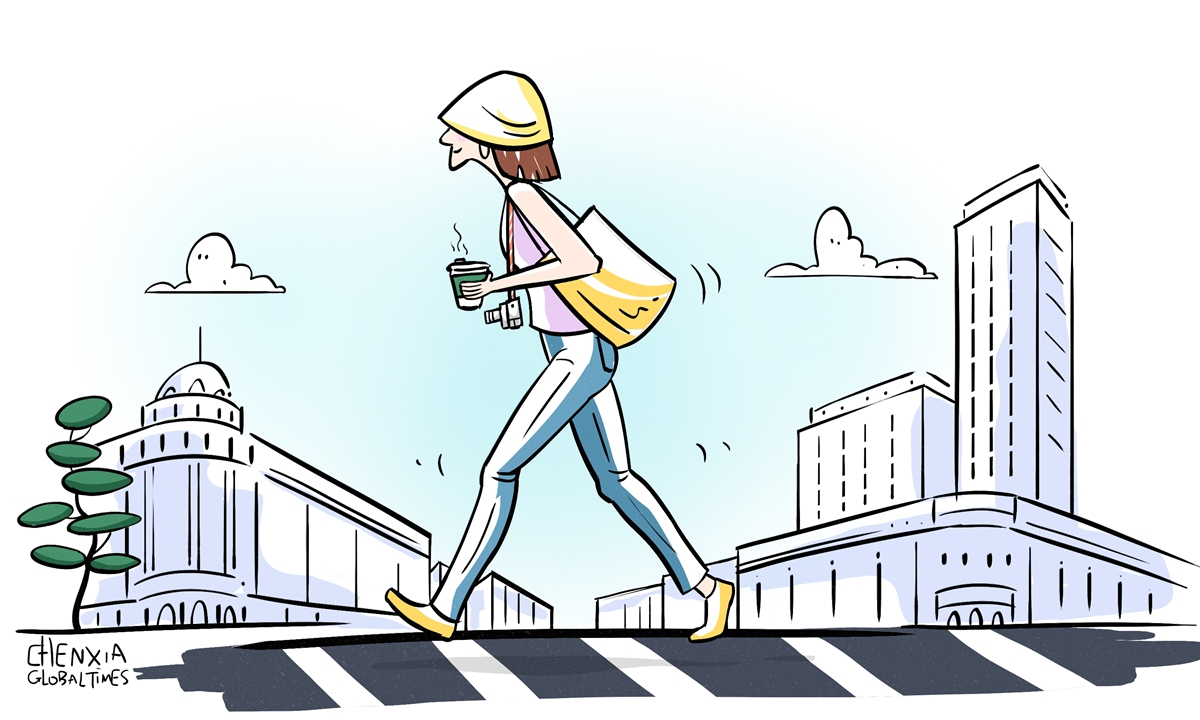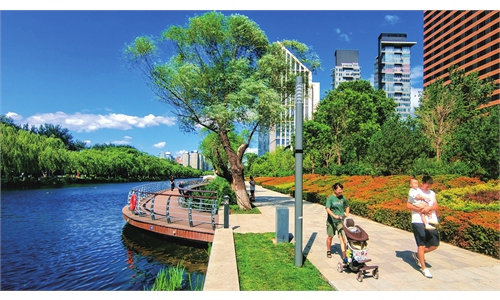ARTS / CULTURE & LEISURE
Trending city walks bring people closer to real vibe of life

Illustration: Chen Xia/Global Times
Recently, the "city walk" trend has been gaining steam among residents and tourists around China. On trend bible Xiaohongshu, data shows that the number of city walk-related topic posts has increased by 700 percent over the past three months, and the total number of interactions has increased by more than 600 percent.A city walk is a form of urban tourism originating in the UK. It referred to guided tours where participants followed a planned route under the guidance of tour guides, with a strong emphasis on delving deep into the city's history, culture and landscapes among other aspects. Unlike traditional sightseeing, which aims to hit famous attractions and commercial hubs, usually by vehicles with tense schedules, city walk routes are unique. They often bring unexpected joy to tourists with a warm, touching, or shocking cultural experience through an intelligent arrangement of less well-known spots. Nowadays, city walkers are likely to choose a route and move on foot without a particular destination, seeking out interactions with locals on their way.
City walkers may be tourists from afar or migrant workers and locals. For the former, by participating in a city walk, they can gain insight into the city's history, culture, and style, which allows them to connect personally with the city and experience its bustling life. For the latter two, they may spend weekends gaining a deeper understanding of their place of residence, reconnecting with that which they are familiar. Seasoned city walkers share their recommended routes and snack spots on social media and quickly rack up thousands of fans. Districts and streets with a great historical or cultural atmosphere in major cities such as Beijing, Shanghai and Chengdu have become popular city walk routes.
The appeal of a city walk lies in three aspects. First, the young generation gradually changes their attitude toward life, pursuing quality leisure time while being occupied with demanding workloads and limited time for exploration. The streets and buildings may stay the same, but the people they meet change. They may not witness the beautiful views they would in the countryside, but they do get an endless procession of exciting faces.
Second, walking regularly is good for mental and physical health. Research shows that it significantly lowers your chances of developing vascular dementia, boosting your immune system and making for a healthier heart. While strolling along the road, you can entirely focus on yourself and listen to your inner voice and care for what you feel, which is a way to love yourself and benefit your psychological well-being. Oscar Wilde once said, "To love oneself is the beginning of a lifelong romance." However, don't do it just because it's good for you, do it because it's fun.
Last, city walkers are a cast of people who possess intense curiosity. They are keen to connect with the city in which they are stopping or reside in their own way. By "roaming" on foot, city walkers are better able to feel the texture and listen to the breath of a place. They seek pleasure more through connection than consumption, which signifies a deep cultural curiosity. For example, in Southwest China's Chongqing Municipality, if you don't take a walk, you can hardly experience the unique geographical charm of the mountainous city. Be it the hutong in Beijing or the Chinese parasol tree district in Shanghai, city walks allow people to see the scenery apart from the scene and uncover hidden knowledge.
We never need worry that city walks will become a huge trend because this phenomenon has people abandon the tense tick-off-spots style of travel to pursue a deep and theme-oriented tour that integrates personal thinking and aesthetic preferences. We are concerned, however, that the tourist industry will misuse it as a profitable symbol and decrease its creativity and uniqueness. Rigid implantation of a route without understanding its culture and historical background may disinterest and disappoint tourists.
Even if you haven't been on a trip recently, just pay attention to your surroundings, and it's not difficult to find trending signposts saying "I'm waiting for you at such and such." These originally so-called golden sentences can now be seen so frequently at almost every tourist attraction that visitors cannot be moved or impressed by these phrases any more. The same challenge is faced by city walks as well. To avoid the risk of simple replication, it is necessary to incorporate unique ideas and affection throughout the route design.
City walks are becoming increasingly accepted and acknowledged by more and more people, which also creates opportunities to upgrade the tourism industry. This summer, free of the pandemic, the scene of jostling crowds in scenic areas has returned, and many people feel both love and hate about traveling. Traditional travel agencies and business models are confronted with challenges. Well-planned city walk routes provide alternatives for travelers who are not willing to "follow the crowd" to taste the various flavors of a destination and avoid long queues and traffic congestion. In this context, city walks benefit not only the cultural and tourism industry but also urban development and construction.
The author is a faculty member with the School of Applied Economics, Renmin University of China. life@globaltimes.com.cn

